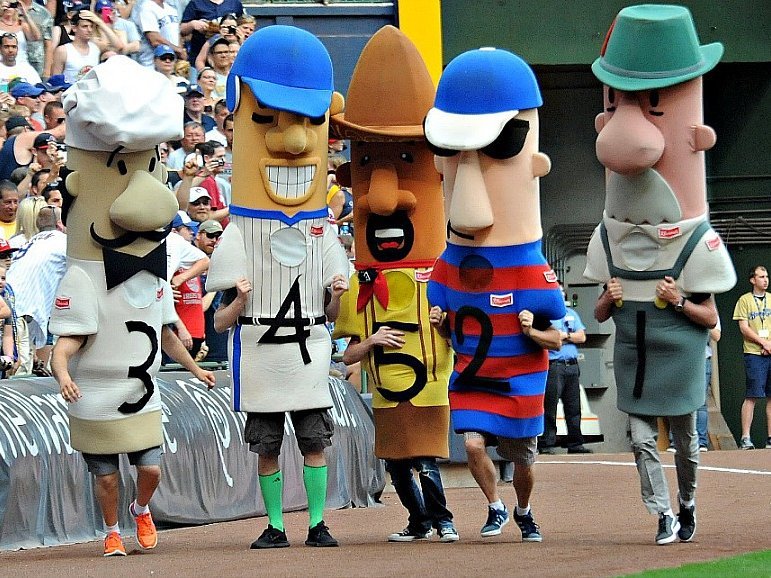People around Major League Baseball are taking notice – and offering their approval – of David Stearns’ extensive, industrious and forward-thinking efforts to revamp the Brewers’ organization, particularly in the personnel and operations departments.
Since taking over last September, Milwaukee’s first-year general manager has been on a crusade to acquire prospects and rebuild the club from the ground up, adding both quantity and quality at its minor-league levels in hopes of being a winner again in a few seasons. After making a pair of deadline trades Monday that netted multiple highly touted young players, the Brewers on Wednesday found themselves with the No. 1 farm system in baseball, according to MLB.com’s midseason rankings.
Stearns has followed the homegrown-development template of teams like the Chicago Cubs, now the best team in the game following five years of losing, and the Houston Astros, where as assistant GM he helped with their turnaround from the majors’ worst record in 2013 to the playoffs in 2015, to try and make Milwaukee a smarter, stronger, more progressive, postseason-frequenting franchise.
Aggressively and unapologetically, Stearns has shed veterans, payroll and most remnants of the Brewers’ last decade of contention, stockpiling young, controllable talent through deals and the draft. Before this season began, Milwaukee’s farm system ranked ninth – boosted by 2015 midyear trades before Stearns arrived and a flurry of transactions he completed in the fall and winter – with five prospects ranked in MLB’s Top 100.
After trading All-Star catcher Jonathan Lucroy and relievers Jeremy Jeffress and Will Smith to the Rangers and Giants in exchange for a trio of promising minor leaguers – outfielder Lewis Brinson and pitchers Luis Ortiz and Phil Bickford – as well as young catcher Andrew Susac and a player to be named later, Stearns’ dramatically improved the organization’s depth. The Brewers now possess eight Top 100 prospects, with a good balance of pitchers and hitters, who were acquired in a variety of ways.
Recently promoted shortstop Orlando Arcia (No. 13 overall) was a product of the club’s international development program; Brinson (21), pitcher Josh Hader (43), Ortiz (63), Bickford (65) and outfielder Brett Phillips (76) were obtained in trades; outfielders Corey Ray (35) and Trent Clark (74) were drafted by the team.
Stearns has made a dozen deals in his 11 months on the job, receiving not only minor leaguers, but also young players that have helped the present big-league team and could conceivably be part of the much-discussed future, including Jonathan Villar and Keon Broxton.
The GM has reiterated there’s no timetable for a return to winning and that he’s just interested in stacking good decisions on top of other good decisions, and his moves reflect that. Drafting the 21-year-old Ray, a college junior from Louisville, and calling up 22-year-old Arcia on Tuesday could be seen as evidence that the Brewers believe they’ll compete sooner than later; but offseason trades for young infielder Isan Diaz, obtained from Arizona, and the trio of teenage pitchers acquired from Seattle, could suggest the franchise isn’t as close.
Above all, Stearns’ desire is simply to bring in as much talent as possible and figure out the rest – positions, player ages, competition windows, etc. – later.
Milwaukee is still two or three years away from harvesting the hopeful fruits of Stearns’ labor. But its clear direction, development-oriented process, positive validation around the league and mix of high-potential prospects and exciting-to-watch major leaguers – not to mention the recent success of the Cubs and Astros using similar blueprints – makes the Brewers’ rebuild a little bit more enjoyable and their organizational outlook a lot more optimistic.
Born in Milwaukee but a product of Shorewood High School (go ‘Hounds!) and Northwestern University (go ‘Cats!), Jimmy never knew the schoolboy bliss of cheering for a winning football, basketball or baseball team. So he ditched being a fan in order to cover sports professionally - occasionally objectively, always passionately. He's lived in Chicago, New York and Dallas, but now resides again in his beloved Brew City and is an ardent attacker of the notorious Milwaukee Inferiority Complex.
After interning at print publications like Birds and Blooms (official motto: "America's #1 backyard birding and gardening magazine!"), Sports Illustrated (unofficial motto: "Subscribe and save up to 90% off the cover price!") and The Dallas Morning News (a newspaper!), Jimmy worked for web outlets like CBSSports.com, where he was a Packers beat reporter, and FOX Sports Wisconsin, where he managed digital content. He's a proponent and frequent user of em dashes, parenthetical asides, descriptive appositives and, really, anything that makes his sentences longer and more needlessly complex.
Jimmy appreciates references to late '90s Brewers and Bucks players and is the curator of the unofficial John Jaha Hall of Fame. He also enjoys running, biking and soccer, but isn't too annoying about them. He writes about sports - both mainstream and unconventional - and non-sports, including history, music, food, art and even golf (just kidding!), and welcomes reader suggestions for off-the-beaten-path story ideas.







